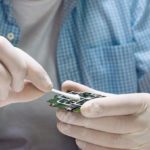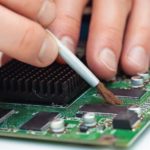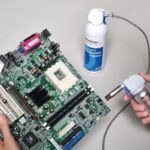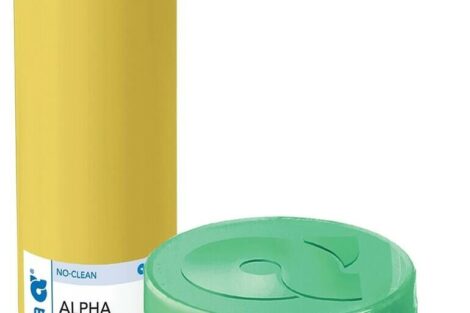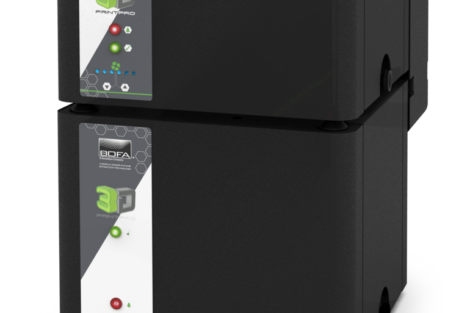Anything left on the board that isn’t meant to be there may negatively affect the performance of the board. This is why so many companies consider PCB cleaning a mission-critical process. If the cleaning is not effective, the finished product simply will not function reliably for the required life of the product. Better cleaning directly translates to more reliable PCBs, which means better finished consumer and industrial electronics in the market.
There are three primary methods and tools used to clean circuit boards at the bench top: Dip and wipe, aerosol sprays and dispensing tools.
1. The dip and wipe technique
The dip and wipe technique typically uses an acid brush and a pump bottle of IPA (Isopropyl Alcohol). Some may also use a swab with the fluid. Most PCB cleaning experts do not recommend this type of cleaning because it often results in a cross-contaminated PCB.
For instance, when flux residue is spot-cleaned from a section of a recently soldered PCB, a brush or swab is dipped into the cleaning fluid on the spring top of the pump bottle, and the soldered areas are then wiped. The cleaning fluid dilutes the flux on the PCB, but it only spreads the contamination without actually removing it. Often the diluted flux relocates elsewhere on the PCB including under neighboring SMT components. Some of the flux also makes its way up onto the brush or the swab.
The brush or swab is now a source of contamination as it drags deactivated flux back into the pump bottle. Also, the pump bottle valve gradually clogs with flux residue and fails to re-seal. This allows the dirty cleaning fluid on top of the pump bottle to slip back into the bottle itself. All this adds contamination to the next board when using the cleaning fluid, brush or swab again.
If the dip and wipe method must be used, it is important to rinse the whole board with clean fluid, as well as, to replace the dirty fluid in the pump bottles frequently. The pump bottles must be cleaned, including the bottle valves, prior to refilling them. If using swabs, replacing them with a good quality brush should be done instead. Swabs leave lint and other unwanted contaminants behind. When using brushes, they should be replaced often to avoid cross-contamination.
Dip and wipe cleaning offers little in the way of process control. Some technicians apply more pressure in cleaning than others. Some use too much fluid, and some barely wet the board. Improvised cleaning typically results in inconsistent cleaning results.
As circuit boards become more densely packed and tighter spaced, it is increasingly difficult to use the dip and wipe method and still meet PCB cleanliness standards. Quality cleaning requires pure, fresh cleaning fluid, which cannot be easily achieved with a pump bottle and IPA.
2. Aerosol spray method
Aerosol cleaning solves many of the problems related to the dip and wipe method. Aerosol sprays prevent the introduction of new contaminants by providing a steady stream of uncontaminated fluid throughout the cleaning process.
However, dispensing directly from the can doesn’t allow any real cleaning control. A fan of fluid sprays out over a wide area, resulting in a messy and expensive waste of cleaning fluid. Plus, spraying directly from an aerosol can exposes technicians to excess cleaning fluid fumes which makes for an unpleasant work environment.
Adding a straw attachment allows for more control and delivers the fluid with pin-point accuracy under low-mounted or tight-fitting components. This reduces waste and fumes, but any cleaning power relies solely on the pressure of the fluid to blast out trapped contaminants. And like the dip and wipe method, aerosol sprays do not have any real process controls and results vary widely depending on operator use.
MicroCare’s top ten reasons to switch to a better PCB cleaning fluid
Four-step rule for successful cleaning
Successful PCB cleaning requires four steps. Wet, scrub, rinse and dry. First, wet the board with a pure cleaning fluid to loosen the contaminant. Second, scrub the circuit board with a brush to remove hard-to-remove particulates or oils. Third, rinse away the contaminants with more cleaning fluid. Finally allow the board to air-dry or dry the board with a lint-free wipe.
The dip and wipe method allows for wetting and scrubbing, but makes it impossible to rinse the contamination from the board, so the board looks poorly manufactured and often remains sticky with fluxes even after cleaning.
The aerosol spray method also allows wetting, but doesn’t provide any scrubbing power. A solution is to outfit the aerosol spray can with an attached brush. The cleaning fluid flows through the brush head and allows for good scrubbing of dirty areas.
One of the most important steps for successful PCB cleaning is the rinse. Quality rinsing is essential to quality cleaning. If you can’t rinse, you can’t clean. It is important to ensure that all flux residue washes off the board, otherwise it will be redistributed back onto the board.
3. Controlled cleaning with a dispensing system
When used properly, a controlled dispensing system improves benchtop cleaning results, reduces cleaning fluid waste and enhances worker safety. With a dispenser hose attached to an aerosol can of cleaning fluid, the technician has better control of how much and where the cleaning fluid is dispensed. They spray cleaning fluid exactly where they need it without overspray, reducing wasted fluid.
The dispensing system typically includes options for brush and syringe attachments. They help get under low surface mounted components for more thorough cleaning. The cleaning power of the fluid is augmented by the scrubbing action of the brush. Contamination loosens and rinses away with little effort and minimal cleaner. Technicians typically use up to 60 % less cleaning fluid when they use a controlled dispensing system.
Plus, using a dispensing tool reduces landfill waste. The system uses every drop of fluid inside the aerosol can. It is more environmentally friendly to dispose cans that are not partially filled with residual fluid.
In addition, a dispensing system enhances worker safety. Since the dispensing tools are closed systems, technicians do not pour fluids from pails or drums. This reduces the risk of spills and fire hazards. It also limits worker exposure to fumes. Using a controlled dispensing system also offers consistent cleaning. The entire cleaning process can be standardised and documented to meet ISO or other quality requirements.
For benchtop cleaning effectiveness and safety, a cleaning fluid dispensing system is a simple, yet effective way to help protect workers and deliver consistently clean and reliable circuit boards. It cleans more PCBs with less cleaning fluid which produces cost savings, quality improvements and environmental benefits.
Successful benchtop cleaning requires planning
Modern PCB cleaning is a mission-critical process. If not done correctly, the PCB will not function reliably for the required life of the product, resulting in field failures. Plan and prepare for benchtop cleaning by ensuring the correct method is used to meet specific cleaning challenges.
To clean PCBs effectively and reliably at the benchtop, use the four-step cleaning process of wet, scrub, rinse and dry. Also use an appropriate cleaning fluid and a controlled dispensing system to produce consistently clean PCBs. For help in choosing the best cleaning products, partner with a company that specialises in benchtop cleaning. These experts can recommend the best cleaning fluids and methods that will result in the best clean.
MicroCare Corporation
595 John Downey Drive
New Britain, CT, 06051 USA
Tel.: +1 (860) 827–0626
Website: www.microcare.com
Damit die Leiterplatte zuverlässig über die erforderliche Lebensdauer des Produkts funktioniert, ist eine korrekt durchgeführte und effektive Leiterplattenreinigung in einem vierstufigen Reinigungsprozess mit geeigneter Flüssigkeit unerlässlich.
Pour assurer le fonctionnement fiable du circuit imprimé pendant la durée de vie requise du produit, il est indispensable de nettoyer efficacement et de manière conforme le circuit imprimé avec un liquide approprié durant un processus se déroulant sur 4 phases.
Чтобы печатная плата надежно работала в течение требуемого срока службы изделия, требуется правильно выполненная и эффективная очистка печатной платы подходящей жидкостью в ходе четырехступенчатого процесса.


